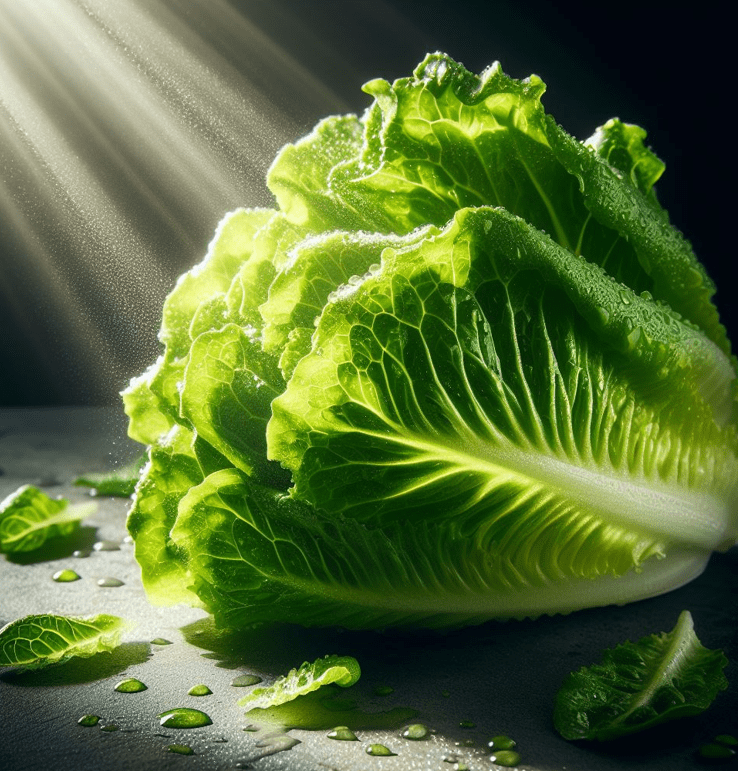Nutrition Facts
Romaine lettuce is an excellent source of essential vitamins and minerals. A one-cup serving provides:
- Vitamin A: Over 80% of your daily recommended intake is essential for vision and immune function.
- Vitamin K: Over 100% of your daily needs, crucial for blood clotting and bone health.
- Folate: A significant amount of this B vitamin is essential for healthy cell division.
- Potassium: A good source of this mineral that helps regulate blood pressure.
How to Choose and Store Romaine
- Look for Crisp, bright green leaves with no browning or wilting. The base should be firm and fresh.
- Store: Wrap unwashed romaine in a damp paper towel and place in a plastic bag in the crisper drawer of your refrigerator. It should last for up to a week.
Ways to Enjoy Romaine Lettuce
- Classic Caesar Salad: The perfect showcase for romaine’s crisp texture and slightly bitter flavor.
- Grilled Romaine: Halve romaine hearts lengthwise, drizzle with olive oil, and grill for a smoky, caramelized side dish.
- Lettuce Wraps: Use large romaine leaves as a healthy and flavorful alternative to tortillas for Asian-inspired lettuce wraps.
Health Benefits of Romaine Lettuce
The rich nutrient profile of romaine lettuce contributes to various potential health benefits. These include:
-
Improved vision: Vitamin A is essential for maintaining healthy vision. Adequate intake of vitamin A can help protect against age-related macular degeneration.
-
Stronger immune system: Vitamin C is a powerful antioxidant that helps boost the immune system. It also helps the body absorb iron, essential for immune function.
-
Reduced risk of cancer: Studies have shown that a diet rich in fruits and vegetables, including romaine lettuce, may help reduce the risk of certain types of cancer, such as colon cancer.
-
Heart health: Vitamin K helps regulate blood clotting and may help reduce the risk of heart disease.
-
Bone health: Calcium, magnesium, and potassium are all essential for bone health. Romaine lettuce is a good source of these minerals, which can help reduce the risk of osteoporosis.
Romaine vs. Other Green Salads
Romaine lettuce is a common leafy green type with large, sturdy, and crisp leaves with a slightly bitter flavor. It is often used in Caesar salads or grilled for a smoky taste. Romaine is rich in vitamin A and folate but has less vitamin K and magnesium than some other greens, such as Swiss chard. Romaine also has a thick center rib that adds crunch and texture to salads.
Green leaf lettuce is another leafy green with soft, tender leaves with a mild flavor. It is usually found in salad green mixes or as a base for lettuce wraps. Green leaf lettuce has more fiber than romaine but less vitamin A and folate. Green leaf lettuce also has a loose head that spreads out and does not have a prominent rib.
Both romaine and green leaf lettuce are nutritious and versatile greens that can be used in various dishes. They have different appearances, tastes, and textures, so you can choose the one that suits your preference and recipe.
Flavor Profile
Romaine has a milder flavor than some lettuces but offers a slight, pleasant bitterness. It’s more flavorful than iceberg lettuce and holds up well to bold dressings and toppings.
Comparisons
- Romaine vs. Iceberg: Romaine boasts far more nutritional value than iceberg lettuce.
- Romaine vs. Spinach: While spinach also packs a nutritional punch, romaine has a milder flavor and a more satisfyingly crisp texture.
How to Grow Romaine Lettuce
-
Choose a planting site. Romaine lettuce thrives in well-drained soil that is rich in organic matter. The ideal pH range is 6.0 to 7.0. If you are planting in an area with heavy clay soil, you may need to amend it with sand or compost.
-
Prepare the soil. To improve drainage and nutrient content before planting, amend the soil with compost or aged manure. If you are planting in a raised bed, fill it with potting soil and compost.
-
Select seeds or transplants. You can plant romaine lettuce seeds indoors about 4-6 weeks before the last frost. Alternatively, you can purchase transplants from a garden center.
-
Plant the seeds or transplants. If you are planting seeds, sow them 1/4 inch deep and 1 inch apart. If you are planting transplants, space them 12-18 inches apart.
-
Watering. Keep the soil moist but not soggy. Romaine lettuce requires about 1 inch of water per week.
-
Fertilizer. Fertilize the plants every 2-3 weeks with a balanced fertilizer.
-
Pest and disease control. Romaine lettuce is generally resistant to pests and diseases. However, it can be susceptible to slugs and snails. You can control slugs and snails by handpicking them or using a slug bait.
-
Harvest. Romaine lettuce is ready to harvest when the outer leaves are about 6 inches long and have a firm texture. You can harvest the outer leaves one at a time or harvest the entire head. To harvest the entire head, cut it off at the base of the plant.
Tips for Growing Romaine Lettuce
- Plant lettuce in a location that receives full sun to partial shade.
- Protect the plants from frost.
- Mulch around the plants to help keep the soil moist and cool.
- Harvest the outer leaves regularly to encourage new growth.
- Divide the plants in the spring to prevent overcrowding.
Additional Information
- Romaine lettuce can be grown in containers.
- Romaine lettuce is a good source of vitamins A, C, and K.
- Romaine lettuce can be used in salads, sandwiches, and wraps.
Troubleshooting
- If your lettuce is wilting, it may not be getting enough water.
- If your lettuce is bolting (flowering), it may be getting too much heat or light.
- If your lettuce is developing bugs, you may need to use an insecticide.
Possible Risks of Eating Romaine Lettuce
While romaine lettuce is generally a safe food, some recent outbreaks of E. coli are associated with romaine lettuce. Therefore, it is essential to choose fresh romaine lettuce that has not been washed and is stored properly. It is also essential to wash romaine lettuce thoroughly before eating it.
Tips for Using Romaine Lettuce in Recipes
Romaine lettuce is a versatile ingredient that can be used in various recipes. Here are a few tips for using romaine lettuce in recipes:
-
Salads: Romaine lettuce is the classic base for salads. It can be used to make simple green salads or combined with other vegetables, fruits, and protein sources to create more elaborate salads.
-
Wraps: Romaine lettuce leaves make great wraps for sandwiches and other fillings. They are a healthy and low-calorie alternative to bread.
-
Soups: Romaine lettuce can be added to soups for a bit of crunch and texture. It can also be used to garnish soups.
-
Curries: To wilt it slightly, romaine lettuce can be added to curries during the last few minutes of cooking. It can also be served on the side as a refreshing garnish.
Conclusion
Romaine lettuce is a nutrient-rich and versatile green that can be enjoyed in various ways. It is an excellent source of vitamins, minerals, and antioxidants, and it may offer various health benefits. With its mild flavor and crisp texture, romaine lettuce is a perfect addition to salads, wraps, soups, and curries. So next time you want a healthy and delicious green, reach for romaine lettuce.








